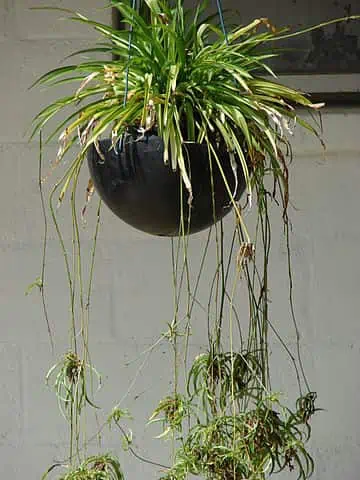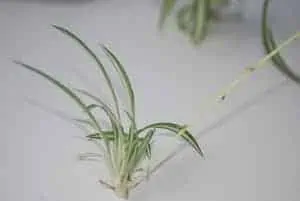Spider plants (Chlorophytum comosum) are the epitome of houseplants. That’s why they remain popular among many enthusiasts and interior designers alike.
But if you have a cat around, you might wonder how safe spider plants are – both from and for your pet.
Spider plants are not toxic to cats. They may have some hallucinogenic effect on your pet, but it’s usually not life-threatening. The American Society for the Prevention of Cruelty to Animals (ASPCA) also listed spider plants as non-toxic to cats and dogs.
That being said, cats and spider plants are not a lethal combination. But it could be challenging keeping both under one roof without proper actions.
Find out what you can do to keep both your cat and spider plant safe from one another.
Table of Contents
How Toxic Are Spider Plants to Cats?
Cats love to chew on some plants, especially their leaves. So, it’s a good thing that spider plants are safe and not at all toxic to your feline pet.
Spider plants, in general, do not contain any toxins that can poison your cat to death.
Unlike other indoor plants such as poinsettias and monstera, cats typically don’t develop alarming immune responses after ingesting spider plant leaves.
However, despite being listed as non-toxic by ASPCA and generally deemed benign, having your cat feed on spider plants can still be disastrous.
For one, cats eating spider plant foliage, especially in high amounts, can experience digestive distress.
You may find your pet vomiting and experiencing stomach aches and diarrhea. This is because a cat’s digestive system is not built for digesting plants outside their tolerable limit.
Likewise, several resources claim that spider plants contain compounds similar to opium, a narcotic substance found in opium poppy. These compounds aggravate poor digestion among cats.
What Happens if Cats Eat Spider Plants?
Cats experience mild hallucinations after eating spider plant leaves. It allows them to be euphoric, relaxed, and generally experience feel-good effects, much like how humans react to opium.
But, as mentioned before, overindulging your feline pet to spider plant leaves – or any non-toxic leaves for that matter – can lead to an upset stomach and watery stool.
Why Are Cats So Attracted to Spider Plants?
It may be more challenging to separate your cat from spider plants as they are drawn to these ornamentals. It’s fascinating how cats get so attracted to spider plants that it’s not uncommon to find them so close to them.
Cats’ attraction to spider plants can be attributed to their scent. While humans lack the inherent sensitivity to notice the smell of spider plants, cats quickly pick it up.
Spider plant scent likely comes from compounds that trigger your cat’s obsessive behavior.
Moreover, spider plants have dangling spiderettes or babies, which is pretty much where their name comes from. Cats love to play with these hanging clusters of leaves.
Do Spider Plant Leaves Grow Back When Eaten by Cats?
Yes, spider plant leaves can grow back even after being eaten by cats.
Spider plant leaves will continue to grow despite some damage. Endurance is one of the many qualities of spider plants that make them the ideal indoor plant.
On the other hand, if your cat’s fixation with spider plant leaves does not stop, it may be high time to relocate the poor plant.
While spider plants will grow strong and healthy despite the chew marks, your cat’s incessant attraction to the plant ruins the ornamental aesthetic.
How To Keep Your Cat Away from Spider Plants?
It might be difficult to control your cat’s instincts regarding spider plants. But, of course, it would take a miracle to let your cat understand it’s prohibited to nibble on the spider plant leaves.
So, one of the most effective actions you can take is cutting off your pet’s access to the plant. If that’s not viable, you can consider making the spider plant less appealing to your feline friend.
For specific ways to keep your cat away from the spider plants, check out the following:
Transfer Your Hanging Spider Plant to a Higher Location
Spider plants are often placed in hanging pots. Their leaves and spiderettes dangle graciously, adding a decorative element to the room.

However, if you positioned your hanging spider plants low enough that cats easily get their paws on them, then it’s time to move the pot higher.
Place your spider plants on a level that’s impossible for your cat to reach.
Remove Any Platform, or Item Your Cat Can Climb On
If your spider plant is in an area far from your cats’ paws, yet they could still get a hold of the leaves, you better inspect for items nearby that they could use as a platform or ladder.
Cats are agile and excellent climbers. So, if you want to ensure that they won’t get into the hanging pots, remove items they can climb on near the spider plants.
Replant the Spiderettes

Spider plants’ spiderettes grow outward, making them dangle from the pot. So, you would naturally, want to cut off these babies and plant them in separate flowerpots.
But even if you don’t intend to propagate the spiderettes, it’s imperative to prune them if you have cats around. Otherwise, these clusters of leaves will extend further down to your cat’s reach.
Spray Your Spider Plant with a Non-Toxic Repellent
Pet repellents are widely available in many stores. They contain safe ingredients that could keep your cat away from nibbling the spider plant leaves.
However, as cats may have varied reactions to generic repellents, it’s still best to consult your vet before using the non-toxic substances.
Rearrange Your Houseplants Strategically
If you have other houseplants around, it could help to position them so that your cat will not go near the spider plant. This works best for spider plants displayed on surfaces.
For example, if you have rosemary around, you could put it beside the spider plant.
The smell of rosemary turns off cats. Hence, they may not even bother getting near your indoor plants.
Bring a Cat Grass Indoors
It sounds odd, but there is such a thing as cat grass. You can check it out here on Amazon

Cats are fond of grass. They play around it and nibble the leaves from time to time. Perhaps that’s also one of the reasons they like spider plants so much – since their leaves are similar to grass.
With that, you could try planting cat grass and bringing it indoors. This could divert the attention of your cat away from the spider plants. You can buy cat grass from your local plant shop or pet store.
Move Your Spider Plant Outside
Sometimes, the best way to keep it far from the spider plant is to move the plant outside with a persistent cat. That way, you’d keep both the cat and spider plant safe.
You can do it temporarily until you can go for other options.
As for the spider plant, you can rest assured that it will not impede its survival unless the weather is cold. By that time, you will have to keep the spider plant indoors.
Final Thoughts
If your cat ingested some spider plant leaves, there’s no need to panic. They are not toxic. Your cat will probably live but watch out for any digestive distress.
So, if your cat starts to vomit or excrete watery stool, contact your vet and check for bite marks on your spider plant leaves.
Despite being non-toxic, it would give you peace of mind if your cat refrains from chewing on your spider plant. Then, your cat can remain healthy, and the spider plant will maintain its gracious form.
Recent Posts
Have you found yourself wondering, 'why is my bamboo growing so slow?' Despite the fact that bamboo plants are remarkably fast-growing, it can sometimes take months (or even years!) to see any signs...
Miracle-Gro is a huge help when you are trying to get decent yields out of your plants or if you want them to thrive. However, you may have noticed that a single dose of fertilizer does little to...
